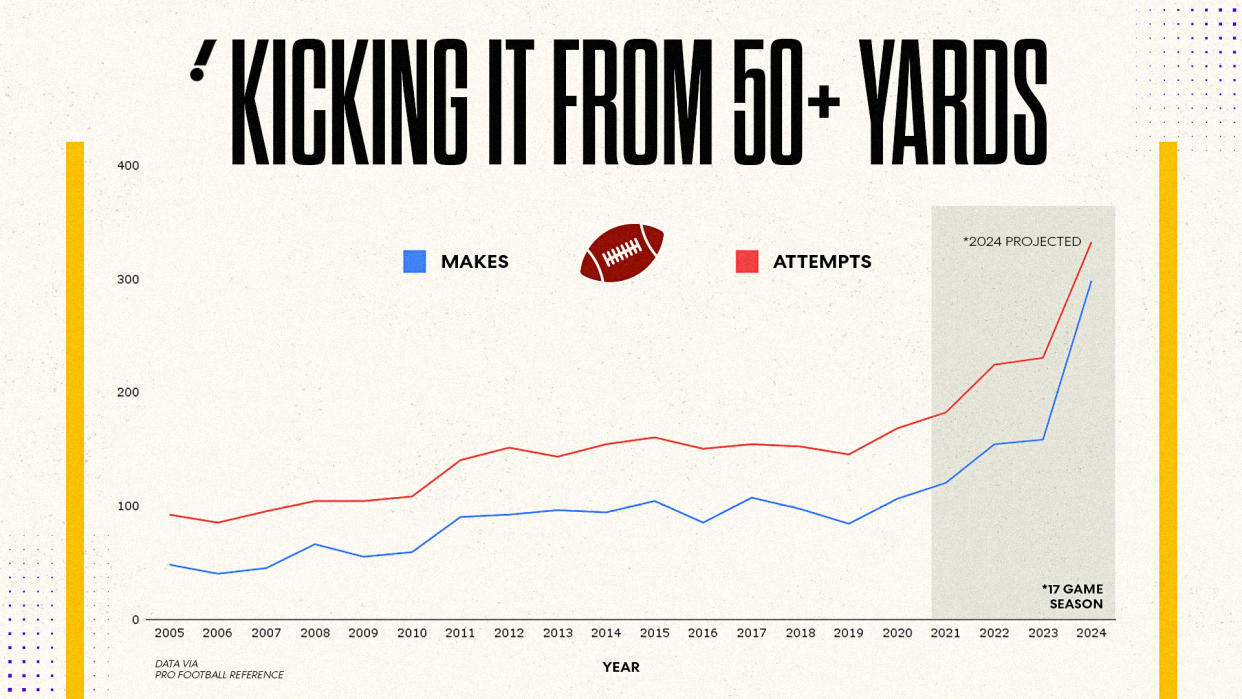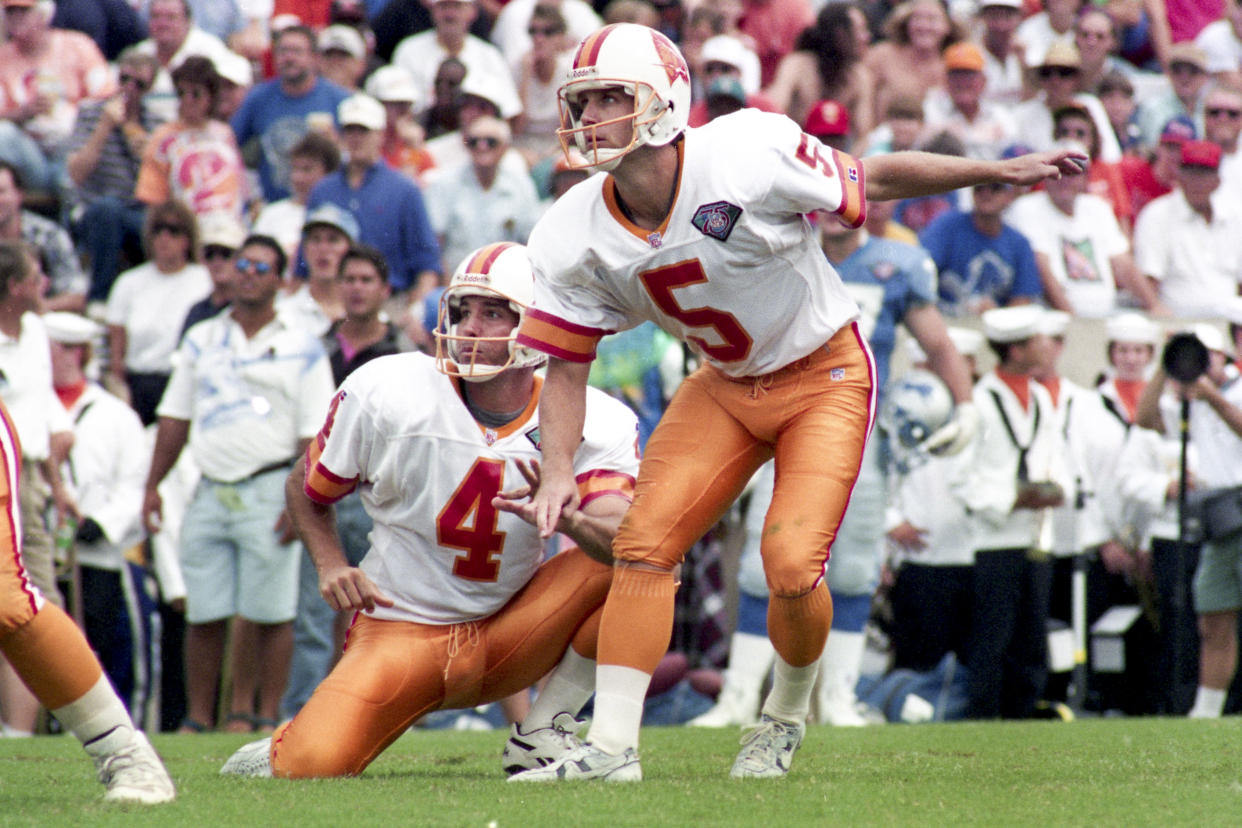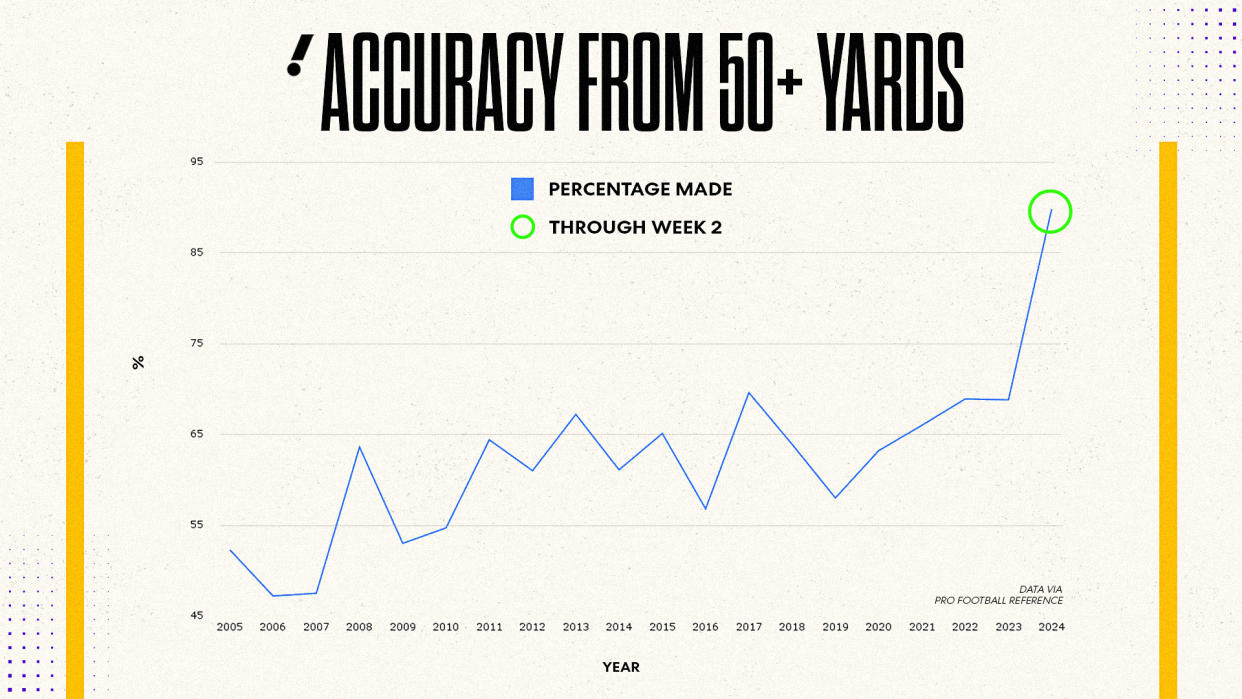Have NFL kickers gotten so good a rule change is in order?
On Sept. 28, 2008, then Oakland Raiders head coach Lane Kiffin infamously sent out Sebastian Janikowski to try a 76-yard field goal. It fell short by almost 20 yards and the NFL world laughed, contributing to Al Davis’ decision to fire Kiffin just two days later.
Sixteen years later, Dallas Cowboys head coach Mike McCarthy initially wanted Brandon Aubrey to attempt a 71-yarder just before halftime of the team’s season opener two Sundays ago. When McCarthy ultimately decided it was too risky, the NFL world didn’t laugh. Rather, it screamed for him to reconsider.
Those contrasting reactions reflect how ridiculously good NFL kickers have gotten over the past decade or two. They’re now hitting long-distance field goals with the ease of Steph Curry sinking an impossibly deep 3-pointer or Scottie Scheffler bombing a 300-yard drive down a fairway.
Thirty-nine times during the first two weeks of the 2024-25 season, NFL kickers have lined up to try a field goal from 50-plus yards. They’ve converted all but four of those kicks, with the most accurate kicker in NFL history, Justin Tucker, improbably responsible for two of the misses.
Never before have NFL kickers hit 35 field goals from 50 yards or beyond in a two-week period. As recently as 2006, they made only 40 field goals from that distance in an entire season.
Never before have NFL kickers made 89.7% of their 50-plus-yard field goals during the opening two weeks of the season. As recently as 2007, the league’s kickers missed more field goal tries than they made from 50 yards and beyond.
Yes, kicking stats tend to wane over the course of a season as the weather turns blustery and field conditions worsen, but there’s reason to expect this trend to have staying power. Many NFL coaches appear to trust modern kickers from distances they once would have deemed too big a gamble. And with the NFL’s new touchback rule giving the receiving team the ball at its own 30-yard line, teams need only a single explosive play or a couple first downs to cross midfield and give their big-legged kicker a chance.
If this field-goal explosion doesn’t slow down, it will raise questions that would have been unfathomable not that long ago: Are NFL kickers getting too good? Might the league need to explore doing something to make field goals less automatic?

Kicking is no longer an afterthought
When he first tried out to play football in ninth grade, Michael Husted recalls the coach asking all the players if any of them could kick.
At first, Husted kept quiet because he envisioned playing quarterback or receiver. Only after no one else put their hand up did Husted raise his.
“I play soccer,” Husted said.
“Alright, you’re our kicker!” his coach responded.
The first time Husted kicked in front of his team, the only real instruction he received was to take three steps back, two steps over and kick the ball. It sounded easy enough to Husted until he went to plant, lost his footing on the wet grass and fell on his butt.
After a couple better attempts kicking the ball both straight-on and soccer style, Husted asked his coach which way he preferred. The coach told Husted, “Son, I don’t care if you kick it with your ass. Just get the ball through the uprights.”

That inglorious introduction to place kicking more than three decades ago was how Husted’s path to the NFL began. He blossomed into an all-state kicker at Hampton High, walked on at Virginia and carved out a nine-year NFL career.
Husted, now a kicking coach, chuckles when describing how different the kicking landscape is today compared to when he grew up. The stereotype of the scrawny, unathletic kicker has gradually eroded. The level of athlete drawn to the position has improved so much that modern NFL kickers might flaunt a 42-inch vertical on social media, bench press 225 pounds 25 times in a row or run a 4.79-second 40-yard dash.
Today’s top young kickers often specialize in the position as early as middle school and benefit from increased access to private lessons and instructional camps. Those who can afford it often hire a former NFL or college kicker to help them hone their technique. Others might splurge on a trainer who can design workouts specific to the kicking position or a sports psychologist who can recommend ways to visualize success.
“When I was coming out of high school, there was maybe one kicking camp in the whole country,” Husted said. “Now there’s a pop-up shop on every corner.”
Subscribe to Yahoo Sports NFL on Apple Podcasts, Spotify or wherever you listen.
As the caliber of kickers entering the NFL has improved, so has the conditions they encounter when they arrive. Advances in grass maintenance and field turf have provided kickers a pristine surface. The K-balls used for kicking are less slick and better broken-in. And then there are the other specialists who snap and hold the ball.
Ex-Pro Bowl kicker Mike Hollis told Yahoo Sports he seldom had a full-time long snapper when he played for the Jacksonville Jaguars from 1995-2001. Rather than expend a roster spot on a specialist, the Jaguars preferred to train a tight end or offensive lineman to handle long-snapping duties.
Since those players were busy with their primary responsibilities during most of practice, Hollis rarely had more than a few minutes a day to work with his whole field-goal operation. One year, the Jags even practiced punting and field-goal drills simultaneously, meaning that Hollis worked with only his primary long snapper and holder on game days.
In the modern NFL, teams value the kicking game too much to repeat those mistakes. The field-goal unit develops timing and continuity through daily practice reps because the long snappers are now specialists and punters typically serve as holders.
“Snappers now are so good that they count the rotations of the ball so that it reaches the holder with the laces perfectly forward,” Hollis said. “All the holder has to do now is put the ball down and put his hand on top of the ball.
“It was not like that back in the day when I played. I had a plethora of snappers that weren't just snappers. Their priority was other positions. Snapping was kind of a secondary thing, so they weren't as good, clearly, as the guys who specialize these days.”
All those factors have contributed to the kicking position evolving as quickly as any across sports. Mike Vanderjagt retired in 2006 as the most accurate kicker in NFL history. Less than two decades later, the former Indianapolis Colts standout has already slipped to No. 9 and will soon fall out of the top 10 once Aubrey or Cameron Dicker get to 100 field-goal attempts.
A decade ago, kickers became so automatic booting extra points that the NFL competition committee began exploring the need for change. The ideas that the committee considered offer a hint at what options the NFL might consider if field goals percentages start to soar.

Narrow the goal posts?
Excuse the kickers invited to the 2015 Pro Bowl if they considered turning down the honor.
The NFL used that year’s all-star game to experiment with two new ways of challenging kickers, increasing the distance of extra points to 33 yards and narrowing the width of the goal posts from 18 feet, 6 inches to 14 feet.
The changes contributed to the legendary Adam Vinatieri botching a pair of extra points and a potential game-tying 38-yard field goal. Vinatieri criticized the tweaks before and after the game, likening them to if the NFL prohibited receivers from wearing gloves because they were catching the ball too well.
“I understand that the wheels of change are in motion and people want to change stuff,” Vinatieri told reporters, “but I feel bad for the young bucks that will have to deal with that their whole career."
Seeking to add intrigue to one of football’s most predictable plays, the NFL adopted the longer extra points the following season. Kickers went from converting 99.3% of extra points in 2014 to 94.2% in 2015, though the rate of success has since rebounded somewhat as NFL veterans have adjusted.
Unconvinced that there was a need to make field goals less automatic nine years ago, the NFL opted against narrowing the uprights. The competition committee hasn’t dabbled with the idea again even as kickers have gradually become more dependable from distances and coaches have shown more willingness to try long field goals once deemed too risky.
Assuming those trends continue, Husted said he considers the NFL narrowing the uprights to 13 or 14 feet an “inevitable next evolution.” If that happens, Husted would like to see the NFL make 50-plus-yard field goals worth four or five points.
“They do it in fantasy,” he added. “Why not do it for real?”
Hollis also predicted that the NFL will someday explore potential changes if kickers continue to get more accurate. Narrowing the uprights or raising the crossbar are the obvious answers, Hollis said, but he expressed hope that the NFL would consider something creative like adding a second set of skinny goal posts and awarding bonus points when a kick goes through both.
More adamantly opposed to narrowing the uprights is 15-year NFL veteran Nick Novak, now a private kicking coach and showcase host in the San Diego area. He told Yahoo Sports that he doesn’t see a need to make field-goal kicking harder than it already is.
“But if you narrowed it, I think guys would adapt,” Novak said. “I truly believe that. I think there would be a transition period like there was with the longer extra points and then guys would ultimately adapt and overcome and be just as good as they are now.”
The evidence of how good NFL kickers are has come in bunches the past two weeks. Houston’s Ka'imi Fairbairn has connected on six field goals from 50 or more yards. Washington’s Austin Seibert hit seven field goals in a single game.
Maybe the strongest example is an exchange between McCarthy and special teams coordinator John Fassel just before Aubrey's near attempt at the 71-yarder two Sundays ago.
When the Cowboys took over the ball at their own 40-yard line with nine seconds left until halftime, McCarthy wasn't content to drain the clock and protect a three-score lead. He asked Fassel how far the Cowboys needed to advance the ball to get Aubrey into field-goal range.
"Just across the 50," Fassel responded, and no one laughed.


